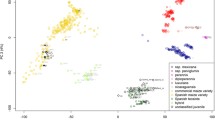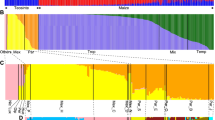Abstract
Maize (Zea mays L. ssp. mays) was domesticated from one wild species ancestor, the Balsas teosinte (Zea mays ssp. parviglumis) about 9000 years ago. Higher levels of gene diversity are found in teosinte taxa compared to maize, following domestication and selection bottlenecks. Diversity in maize can be increased via gene flow from teosinte, which has certainly occurred from various taxa, but the rate of flow from different teosinte taxa and the final impact on maize evolution has been difficult to measure. One hundred populations from six Zea taxa, both domesticated (maize) and wild (teosinte), including domesticated landraces from Asia, Africa, and the Americas, were genotyped with 17 SSR markers using 15 individuals per population. Overall levels of diversity were high, and populations could be distinguished based on markers. Relationships between populations followed most published reports, or can now help resolve previously conflicting reports. Gene flow into maize from different teosinte groups, and gene flow between different teosintes, was estimated. Evidence for contributions from the Balsas teosintes and from Chalco teosintes (Z. mays ssp. mexicana) to the maize gene pool was found, as well as from Chalco into ssp. mexicana race “Durango” and Z. mays ssp. huehuetenengensis. These contributions are almost certainly the result of post-domestication (and ongoing) exchanges. This information must give more impetus to in situ conservation of teosinte species, and use of these teosintes to continue to direct the evolution of maize, especially in response to new diseases, insect pests, and other biotic and abiotic stresses.

Similar content being viewed by others
References
Allen JO, Emenhiser GK, Kermicle JL (1989) Miniature kernel and plant: interaction between teosinte cytoplasmic genomes and maize nuclear genomes. Maydica 34:277–290
Amusan IO, Richi PJ, Menkir A, Housley T, Ejeta G (2008) Resistance to Striga hermonthica in a maize inbred line derived from Zea diploperennis. New Phyt 178:157–166
Baltazar BM, Sanchez Gonzalez JJ, de la Cruz-Larios L, Schoper JB (2005) Pollination between maize and teosinte: an important determinant of gene flow in Mexico. Theor App Genet 110:519–526
Beadle GW (1932) Studies of Euchlaena and its hybrids with Zea. I. Chromosome behavior in Euchlaena mexicana and its hybrids with Zea mays. Die Zygodactylie und ihre Vererbung 62:291–304
Beadle GW (1939) Teosinte and the origin of maize. J Hered 30:245–247
Bellon MR, Berthaud J, Smale M, Aguirre JA, Taba S, Aragon F, Diaz J, Castro H (2003) Participatory landrace selection for on-farm conservation: an example from the Central Valleys of Oaxaca, Mexico. Genet Res Crop Evol 50:401–416
Benz BF, Sanchez-Velasquez LR, Santana Michel FJ (1990) Ecology and ethnobotany of Zea diploperennis: preliminary investigations. Maydica 35:85–98
Blancas L, Arias DM, Ellstrand NC (2002) Patterns of genetic diversity in sympatric and allopatric populations of maize and its wild relative teosinte in Mexico: evidence for hybridization. In: Snow A (ed) Scientific methods workshop: ecological and agronomic consequences of gene flow from transgenic crops to wild relatives. Ohio State University, Columbus, pp 31–38
Buckler ES, Holtsford TP (1996) Zea systematics: ribosomal ITS evidence. Mol Biol Evol 13:612–622
Buckler ES, Stevens NM (2005) Maize origins, domestication and selection. In: Motley TJ, Zerega N, Cross HB (eds) Darwin’s Harvest. New approaches to the origins, evolution, and conservation of crops. Columbia University Press, NY
Buckler ES, Thornsberry JM, Kresovich S (2001) Molecular diversity, structure and domestication of grasses. Genet Res 77:213–218
Buckler ES, Gaut BS, McMullen MD (2006) Molecular and functional diversity of maize. Curr Op Plant Biol 9:172–176
Collins GN (1919) Structure of the maize ear as indicated in Zea-Euchlaena hybrids. J Ag Res 17:127–135
Doebley JF (1990) Molecular evidence and the evolution of maize. Econ Bot 44:6–27
Doebley J (2004) The genetics of maize evolution. Ann Rev Gen 38:37–59
Doebley JF, Goodman MM, Stuber CW (1984) Isoenzymatic variation in Zea (Gramineae). Sys Bot 9:203–218
Doebley J, Renfroe W, Blanton A (1987) Restriction site variation in the Zea chloroplast genome. Genetics 117:139–147
Dubreuil P, Warburton M, Chastanet M, Hoisington D, Charcosset A (2006) More on the introduction of temperate maize into Europe: large-scale bulk SSR genotyping and new historical elements. Maydica 51:281–291
Ellstrand NC, Garner LC, Hegde S, Guadagnuolo R, Blancas L (2007) Spontaneous hybridization between maize and teosinte. J Hered 98:183–187
Emerson RA, Beadle GW (1932) Studies of Euchlaena and its hybrids with Zea. II. Crossing over between the chromosomes of Euchlaena and those of Zea. Z für induk Abst Vererb 30:5–15
Eubanks MW (2001) The mysterious origin of maize. Econ Bot 55:492–514
Evans MMS, Kermicle JL (2001) Teosinte crossing barrier1, a locus governing hybridization of teosinte with maize. Theor Appl Genet 103:259–265
Eyre-Walker A, Gaut RL, Hilton H, Feldman DL, Gaut BS (1998) Investigation of the bottleneck leading to the domestication of maize. Proc Nat Acad Sci 95:4441–4446
Franco J, Warburton M, Dubreuil P, Dreisigacker S (2005) User’s Manual for the FREQS-R Program for estimating allele frequencies for fingerprinting and genetic diversity studies using bulked heterogeneous populations. CIMMYT, Mexico, DF
Fukunaga K, Hill J, Vigouroux Y, Matsuoka Y, Sanchez J, Liu L, Buckler ES, Doebley J (2005) Genetic diversity and population structure of teosinte. Genetics 169:2241–2254
Gauthier P, Gousenard B, Dallard J, Redaelli R, Rebourg C, Charcosset A, Boyat A (2002) RFLP diversity and relationships among traditional European maize populations. Theor Appl Genet 105:91–99
Hamblin MT, Warburton ML, Buckler ES (2007) Empirical comparison of simple sequence repeats and single nucleotide polymorphisms in assessment of maize diversity and relatedness. PLoS One doi:10.1371/journal.pone.0001367
Iltis HH (1983) From teosinte to maize: the catastrophic sexual transmutation. Science 222:886–894
Kato TA (1976) Cytological studies of maize (Zea mays L.) and teosinte (Zea mexicana (Schrader) Kuntze) in relation to their origin and evolution. Mass Ag Exp Sta Bull 635:1–186
Kato TA (1984) Chromosome morphology and the origin of maize and it’s races. In MK Hecht et al. (eds) Evolutionary Biology, New York, pp 219-253
Kato TA, Mapes C, Mera LM, Serratos JA, Bye RA (2009) Origen y diversificación del maíz: una revisión analítica. Universidad Nacional Autónoma de México, Comisión Nacional para el Conocimiento y Uso de la Biodiversidad. Mexico, DF
Langham I (1956) Botanical gardens in ancient Mexico. Ann Mo Bo Garden 44:17–31
Liu J, Muse SV (2005) PowerMarker: integrated analysis environment for genetic marker data. Bioinformatics 21:2128–2129
Longley AE (1941) Chromosome morphology in maize and its relatives. Bot Rev 7:263–289
Matsuoka Y, Vigouroux Y, Goodman MM, Sanchez J, Buckler E, Doebley J (2002) A single domestication for maize shown by multilocus microsatellite genotyping. Proc Nat Acad Sci 99:6080–6084
Menkir A, Kling JG, Badu-Apraku B, Ibikunle O (2006) Registration of 26 tropical maize germplasm lines with resistance to Striga hermonthica. Crop Sci 46:1007–1009
Nuttall Z (1925) The gardens of ancient Mexico. Ann Rep Smithsonian Inst 1923:453–464
Perrier X, Jacquemoud-Collet JP (2006) DARwin software http://darwin.cirad.fr/darwin
Piperno DR, Flannery KV (2001) The earliest archaeological maize (Zea mays L.) from highland Mexico: new accelerator mass spectrometry dates and their implications. Proc Nat Acad Sci 98:2101–2103
Pressoir G, Berthaud J (2004) Patterns of population structure in maize landraces from the Central Valleys of Oaxaca in Mexico. Heredity 92:88–94
Pritchard JK, Stephens M, Donnelly P (2000) Inference of population structure using multilocus genotype data. Genetics 155:945–959
R Development Core Team (2009) R: a language and environment for statistical computing. R Foundation for Statistical Computing, Vienna, Austria
Rebourg C, Chastanet M, Gouesnard B, Welcker C, Dubreuil P, Charcosset A (2003) Maize introduction into Europe: the history reviewed in the light of molecular data. Theor Appl Genet 106:895–903
Reif JC, Hamrit S, Heckenberger M, Schipprack W, Maurer HP, Bohn M, Melchinger AE (2005) Genetic structure and diversity of european flint maize populations determined with SSR analyses of individuals and bulks. Theor Appl Genet 111:906–913
Ross-Ibarra R, Tenaillon M, Gaut BS (2009) Historical divergence and gene flow in the genus Zea. Genetics 181:1399–1413
Sanchez J, Kato TA, Aguilar M, Hernandez JM, Lopez A, Ruiz JA (1998) Distribución y caracterización del teocintle. Libro técnico 2. Instituto Nacional de Investigaciones Forestales. Agrícolas y Pecuarias, Jalisco, México
SAS Institute Inc (2007) SAS OnlineDoc® 9.2. Cary, NC: SAS Institute Inc. USA
Tenaillon MI, U’Ren J, Tenaillon O, Gaut BS (2004) Selection versus demography: a multilocus investigation of the domestication process in maize. Mol Biol Evol 21:1214–1225
Thuillet A, Tenaillon MI, Anderson MK, Mitchell SE, Kresovich S, Stack SM, Gaut B, Doebley J (2008) A weak effect of background selection on trinucleotide microsatellites in maize. J Hered 99:45–55
Van Heerwaarden J, Ross-Ibarra J, Doebley J, Glaubitz JC, Sanchez Gonzalez JD, Gaut BS, Eguiarte LE (2010) Fine scale genetic structure in the wild ancestor of maize (Zea mays ssp. parviglumis). Mol Ecol 19:1162–1173
Vigouroux Y, Glaubitz JC, Matsuoka Y, Goodman MM, Sánchez J, Doebley J (2008) Population structure and genetic diversity of new world maize races assessed by DNA microsatellites. Am J Bot 95:1240–1253
Warburton ML, Reif JC, Frisch M, Bohn M, Bedoya C, Xia XC, Crossa J, Franco J, Hoisington D, Pixley K, Taba S, Melchinger AE (2008) Genetic diversity in CIMMYT nontemperate maize germplasm: landraces, open-pollinated varieties, and inbred lines. Crop Sci 48:617–624
Wellhausen EJ, Roberts LM, Hernández-Xolocotzi E (1952) Races of maize in México. Their origin, characteristics and distribution. Bussey Institution of Harvard University, Cambridge
Wilkes HG (1967) Teosinte: The closest relative of maize. Bussey Institute, Harvard University, Cambridge
Wilkes HG (1979) Mexico and Central America as a centre for the origin of agriculture and the evolution of maize. Crop Imp 6:16–18
Wilkes HG (1996) El teocintle en México: Panorama retrospectivo y análisis personal. In: Serratos JA, Willcox MC, Castillo F (eds) Flujo genético entre maíz criollo, maíz mejorado y teocintle: implicaciones para el maíz transgénico. CIMMYT, México, DF
Wilkes HG (2006) Urgent notice to all maize researchers: disappearance and extinction of the last wild teosinte populations is more than half completed. A modest proposal for teosinte evolution and conservation in situ: the Balsas, Guerrero, Mexico. Maydica 52:49–58
Acknowledgments
The authors thank Drs. V. Mahalakshmi, A. Menkir, Z. Muthamia, S.H. Zhang, Sutrisno, M. Yunus, P. Grudloyma and P. X. Hao for providing maize landraces for the study; Drs. J. Crouch, L. George, M. Tenaillon, B. Baldwin and M. Sawkins for advice on the manuscript, and Mr. H. Chavez and Ms. V. Combes for expert laboratory technical work. Funding was received from the Generation Challenge Program of the Consultative Group on International Agriculture Research.
Author information
Authors and Affiliations
Corresponding author
Rights and permissions
About this article
Cite this article
Warburton, M.L., Wilkes, G., Taba, S. et al. Gene flow among different teosinte taxa and into the domesticated maize gene pool. Genet Resour Crop Evol 58, 1243–1261 (2011). https://doi.org/10.1007/s10722-010-9658-1
Received:
Accepted:
Published:
Issue Date:
DOI: https://doi.org/10.1007/s10722-010-9658-1




